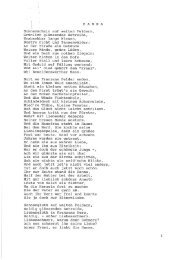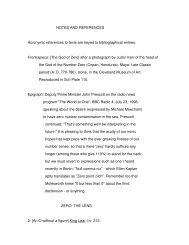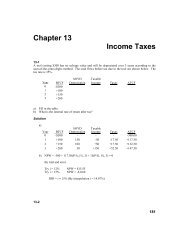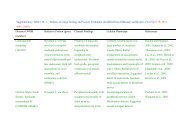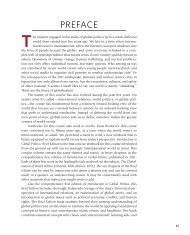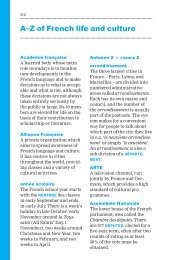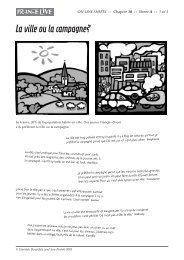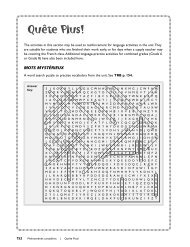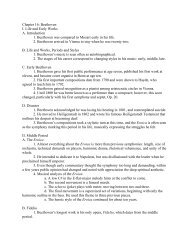CHAPTER 3 Consumer Preferences and Choice
CHAPTER 3 Consumer Preferences and Choice
CHAPTER 3 Consumer Preferences and Choice
You also want an ePaper? Increase the reach of your titles
YUMPU automatically turns print PDFs into web optimized ePapers that Google loves.
03-Salvatore-Chap03.qxd 08-08-2008 12:41 PM Page 75<br />
Constrained utility<br />
maximization The<br />
process by which the<br />
consumer reaches the<br />
highest level of<br />
satisfaction given his or<br />
her income <strong>and</strong> the<br />
prices of goods.<br />
✓ Concept Check<br />
Why is utility not<br />
maximized if the<br />
indifference curve<br />
crosses the budget<br />
line twice?<br />
<strong>CHAPTER</strong> 3 <strong>Consumer</strong> <strong>Preferences</strong> <strong>and</strong> <strong>Choice</strong> 75<br />
curve possible, given his or her budget line. This occurs where an indifference curve is tangent<br />
to the budget line so that the slope of the indifference curve (the MRSXY) is equal to<br />
the slope of the budget line (PX/PY). Thus, the condition for constrained utility maximization,<br />
consumer optimization, or consumer equilibrium occurs where the consumer<br />
spends all income (i.e., he or she is on the budget line) <strong>and</strong><br />
MRSXY = PX/PY<br />
[3.5]<br />
Figure 3.8 brings together on the same set of axes the consumer indifference curves<br />
of Figure 3.2 <strong>and</strong> the budget line of Figure 3.6 to determine the point of utility maximization.<br />
Figure 3.8 shows that the consumer maximizes utility at point B where indifference<br />
curve U1 is tangent to budget line JK. At point B, the consumer is on the budget line <strong>and</strong><br />
MRSXY = PX/PY = 2. Indifference curve U1 is the highest that the consumer can reach with<br />
his or her budget line. Thus, to maximize utility the consumer should spend $4 to purchase<br />
2X <strong>and</strong> the remaining $6 to purchase 6Y. Any other combination of goods X <strong>and</strong> Y that the<br />
consumer could purchase (those on or below the budget line) provides less utility. For<br />
example, the consumer could spend all income to purchase combination L, but this would<br />
be on lower indifference curve U0.<br />
At point L the consumer is willing to give up more of Y than he or she has to in the<br />
market to obtain one additional unit of X. That is, MRSXY (the absolute slope of indifference<br />
curve U0 at point L) exceeds the value of PX/PY (the absolute slope of budget line<br />
JK). Thus, starting from point L, the consumer can increase his or her satisfaction by<br />
purchasing less of Y <strong>and</strong> more of X until he or she reaches point B on U1, where the slopes<br />
of U1 <strong>and</strong> the budget line are equal (i.e., MRSXY = PX/PY = 2). On the other h<strong>and</strong>, starting<br />
from point M, where MRSXY < PX/PY, the consumer can increase his or her satisfaction<br />
by purchasing less of X <strong>and</strong> more of Y until he or she reaches point B on U1, where<br />
MRSXY = PX/PY. One tangency point such as B is assured by the fact that there is an<br />
indifference curve going through each point in the XY commodity space. The consumer<br />
FIGURE 3.8 Constrained Utility Maximization The consumer<br />
maximizes utility at point B, where indifference curve U1 is tangent to<br />
budget line JK. At point B, MRSXY = PX/PY = 2. Indifference curve U1 is<br />
the highest that the consumer can reach with his or her budget line.<br />
Thus, the consumer should purchase 2X <strong>and</strong> 6Y.<br />
Quantity of Y<br />
Q Y<br />
10<br />
8<br />
6<br />
3<br />
J<br />
L<br />
B<br />
M<br />
U<br />
K 0<br />
U 1<br />
0 2 5 9<br />
Quantity of X<br />
U 2<br />
Q X



